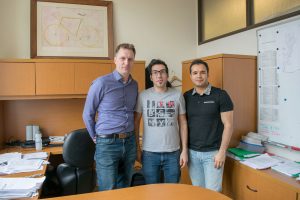University of Toronto researchers identify benefits of self-driving cars

U of T civil engineering professor Matthew Roorda, Ph.D. candidate Sina Bahrami, and Ph.D. graduate Mehdi Nourinejad conducted a study about how self-driving cars can make parking easier for drivers and cities safer. AHMED-ZAKI HAGAR/GLEANER NEWS
By Ahmed-Zaki Hagar
Researchers at the University of Toronto (U of T) have determined that self-driving, or autonomous, cars may be the solution to a common problem of dense urban landscapes: the need for more parking.
Matthew Roorda, a civil engineering professor, Ph.D. student Sina Bahrami, and Ph.D. graduate Mehdi Nourinejad, all at U of T, published a report on a study last month that showed parking lots can accommodate 62 per cent more autonomous cars than cars driven by a person.
“If you sum up all the land that is given to parking in the United States, you have enough land for the state of Connecticut,” Nourinejad said.
The report includes a diagram that compares a conventional parking lot with one designed for self-driving cars.
The conventional lot can hold only four vehicles per row with two cars facing the opposite direction and allowing enough space for drivers to enter and exit.
The autonomous parking lot has six cars per row, however, with three facing the opposite direction, and significantly less space between cars.
The study’s authors believe that conventional parking lots are insufficient compared to automated vehicle parking lots.
“People are not as good at parking as computers,” Roorda said. “You have to allow far more space per car just to allow [for] all the challenges humans have.”
“You cannot block any regular vehicle, because if you park behind another vehicle, at the time that car wants to leave, you have to be in the car to relocate and give some free space for them to leave,” added Bahrami. “But if they are autonomous vehicles, they can move by some communication with each other so that they can be relocated without the driver being there.”
“The better reaction times of self-driving cars over humans should also help curb gridlock,” said Luc Tremblay, an associate professor of kinesiology and physical education who believes autonomous vehicles will have a positive impact on cities like Toronto. “Once a light turns green, a human must detect the change from 0.1 to 0.3 seconds at best, and then move the foot from the brake to the gas pedal in at least another 0.3 to 0.5 seconds.
“In contrast, self-driving cars can detect the change in light faster and immediately accelerate. The human reaction time is compounded such that we sometimes see the light turning green far ahead and know we will not make it through.”
Roorda thinks that self-driving cars would be particularly beneficial to areas like the Annex, because they would provide residents with more transportation options.
“In the Annex, there are choices of getting where you want to go,” he said. “In the Annex and downtown Toronto, most of the things you want to do [are] within walking distance. It is probably likely to first influence people who do a lot of commuting more so than [those who live in] highly-urbanized areas.”
The study also reviewed the City of Toronto’s lack of regulation on automated vehicles.
The authors believe that the city should be preparing to answer big questions about autonomous cars, the technology, and how people interact with them.
“We have to be planning in advance for things like what happens to all of the parking garages that we have,” Roorda said. “If we have vehicle automation, can we take advantage of opportunities to move some of those parking lots from the most valuable land downtown to someplace else?”
“We are still in the testing and piloting phase, we are far behind the U.S. in terms of automation,” added Nourinejad. “The U.S. is starting to move towards policy-making and regulation.”
The researchers can’t predict when fully-automated cars will hit the road here, but noted that “difficult weather” and “complicated driving conditions” are preventing autonomous vehicle tests in Toronto.
“The shortest time period is 10 years up to 40, 50 years,” said Nourinejad.
“And it depends on the kind of automation, we currently have lane assist and adaptive cruise control,” Roorda said. “These are elements of automation we already have on vehicles.
“The removal of the driver from the vehicle is quite a few years away. It takes some time.”
